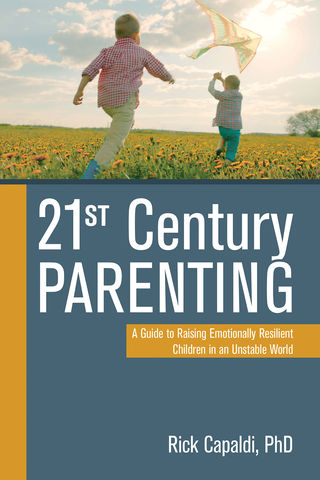Parenting
21st Century Parenting
The Book Brigade talks to individual and family therapist Rick Capaldi.
Posted July 11, 2019

Because children today have so many opportunities to be deflected from the challenges of growing up, parents need to pay attention—the right way. Doing too much for kids can be as bad as giving no direction at all, and may help explain why so many young adults today suffer from anxiety or depression, have an oversize sense of entitlement, or fail to launch at all. It's true that children today face more challenges than earlier cohorts did, but that is all the more reason that parents need to provide direction.
How is it parenting today different from 20th-century parenting?
Past parenting philosophies have parents overreacting, underreacting, or in denial, making excuses for their kids’ behavior, providing choices versus direction, causing children confusion when they need boundaries and direction. Over the past decades, we’ve seen parents beg and negotiate with their kids, making feeble attempts to get them to psychologically buy into the right thing to do, sometimes throwing money, gadgets, and opportunities at them, resulting in the creation of a self-indulging child with a sense of entitlement and a false sense of security. And later they witnessed this blowing up in their children’s face once they reach adolescence or adulthood, where behavior and attitude become far less excusable and accepted.
Today, many adolescents, college-bound young adults, and graduates evidence being unarmed with skillsets and coping mechanisms to deal effectively with the challenges they’re presented and instead continue to demonstrate expectations that the world will treat them in the same manner their parents did—and of course are surprised at the outcome. We see young adults jumping from one job or opportunity to another, or taking an elongated time to finish college, and often returning home due to failed attempts at launching. In general, they are not developing the kind of independence and capability to deal effectively with life’s challenges.
In some cases, these young people demonstrate depression, anxiety, or panic attacks, engage in self-harm, or make poor decisions that impact their success; this is primarily because parents weren’t involved early on and throughout their life, directing, modeling and coaching them away from the sometimes negative alternatives they’ve now turned toward.
This book teaches parents to recognize the challenges and opportunities children face early by putting a new twist to the old 3Rs, suggesting parents need to pay more attention to their child’s world:
• learn to Read their child’s environment, recognize the challenges, conflicts, or opportunities their children are presented with, know who and what influences them, and know how all this affects their performance.
• help Regulate and develop their children’s emotional control. By teaching emotional control, parents can learn how children slip into negative mood states —which, if left uncontrolled, can impact their success, color the decisions they make and the behavior they demonstrate as well as the responses they may seek in their world.
• Redirect their child’s behavior in order to achieve positive outcomes, helping their children accomplish relevant goals that lead to a heightened sense of self-worth, self-assurance, and motivation for their present and future endeavors.
What are the new challenges that parents face and where do they come from?
Today, kids face challenges and dangers that most of us never dreamed of when we were growing up. Online predators, mass school shootings, cyberbullying—all of which can lead to confusion, anxiety, depression, performance issues, and suicidal behavior. In addition, they spend more time staring into screens than we ever imagined, absorbing incredible amounts of information beyond our control. The consequences of these influences, as well as societal pressure, impact their day-to-day life.
In addition, a lack of support and adjustment to family dysfunction, divorce, and remarriage, and a lack of parental awareness on how this impacts their child can often lead to depression and anxiety, difficulty in school as well int relationships as adults. Social media influence, online pornography, substance abuse, and bullying are all alternatives some kids now turn to in order to cope with heightened degrees of emotionality because parents aren’t paying attention. This, together with a lack of healthy coping mechanisms and a lack of positive social interaction and integration with peers, impacts how children deal with the conflict and challenges they are surrounded by and lead to questions about their capability, purpose, and confidence.
What do kids carry in their so-called emotional backpacks that parents might not be too aware of?
Today, a child’s emotional backpack is often crammed with so many concerns and questions that influence their daily life that there’s hardly any room for books. Children pose questions regarding their competency, worth, identity, performance, ability to succeed, security, and safety; they are looking for answers on how to cope and feel good about themselves. And when parents aren’t around to support their kids’ confidence-building, the children often turn to negative alternatives.
Some kids have the answer; they enter school with healthy coping mechanisms that parents help them develop. The result is, they make good decisions and are successful academically, socially, and emotionally. Others—too many others—come in unprepared, without parental support. That may be because of a learning challenge, being victimized by other students, internalizing emotions due to family change. It may be due to anger, resentment, the shame of being homeless, a lack of connection with their social society. All can cause children to turn toward self-harm, poor decision making, isolation, performance problems and other self-destructive behaviors that impact their present and future. If a parent is not paying attention and doesn’t read a child’s signals, the child can go astray and embark on a progressive downward spiral, sometimes making decisions that sabotage wellbeing and performance.
Is there one way to parent that works for all children? Or is there one essential element or task that all parenting must deliver or achieve?
There’s no one way that works for all children. Part of redirecting your child’s behavior is incorporating the Parenting GPS system. Parenting is about leadership. It’s about taking charge and sometimes, yes, having to make the tough, unpopular decision because it’s in the best interest of the child and family.
Parenting GPS is a tool I’ve developed to help parents navigate through the “responsiveness detours” children demonstrate and to redirect their kids toward present and future success. The amount of parental direction needed relates to the level of performance and responsiveness a child demonstrates. A child who is nonresponsive and a poor performer needs parents to provide clear and specific direction for expected results with minimal degrees of reinforcement until the expected change in behavior is visible. A child whose behavior is inconsistent but responsive needs parents to operate as a coach, providing specific direction for expected results as well as equal amounts of reinforcement for the results and behavior they see their child demonstrate.
For the child who’s a consistent performer and cooperative, a parent can be more participatory. Here, less direction is needed because the child demonstrates expected behavior. And the parent acts as a supportive guide, being highly reinforcing. For that child who’s a strong self-reliant, performer, the parent’s job is to negotiate and delegate opportunities. This child, who in most cases, demonstrates expected behavior, needs less direction and less reinforcement due to the performance he/she demonstrates.
So, the key to effective 21st-century parenting is flexibility, matching parental responsiveness and direction to the level of performance their child demonstrates. This process needs to be in constant motion, evaluated, adaptable to the child’s results.
You believe that kids need to be emotionally resilient. How do you define emotional resilience?
Resilience is the ability to bounce back and recover. Unfortunately, resiliency, like self-image and self-concept, is a learned behavior; that means it needs to be taught and supported by parents. You can’t go to Target and find resiliency on aisle 9. Developing resiliency to life’s setbacks is based on the direction and support from the people children rely on; their parents teach them how to bounce back versus shy away from opportunities because of a setback.
A child doesn’t learn emotional resiliency from having things done for them or having excuses made for their behavior. A strong sense of self and motivation to attempt new opportunities is based on a child’s experience, and often that experience is seasoned with setbacks as well as successes. It’s the past experiences and the support and direction children receive from the significant people in their lives that allow them to respond positively and demonstrate emotional resilience throughout their lives.
So, what do children need to develop emotional resiliency? Safety, security, structure, and support from day one. When any one of these components is missing, it has an impact on how a child thinks, feel about themselves and their ability to respond to challenges. Paramount in developing resilience are boundaries so kids know where their starting block is as well as the finish line.
What forces in today’s world do you see working against the cultivation of resilience, and specifically self-regulation?
First, parents need to recognize both resiliency and self-regulation are learned behaviors. A child will not learn to bounce back from difficult situations, challenges or failures or learn to regulate their emotional temperature properly if their parent stands in their way by making excuses for their behavior, doesn’t let them fail or celebrates feeble attempts at success where there have been none. Parental interference can breed learned helplessness or the false illusion that there will always be someone supporting them for their efforts, successful or otherwise.
So first, parents need to acknowledge attempts but only reward and celebrate accomplishments, and to recognize failed attempts as challenges to embrace and overcome. Not establishing a difference between effort and accomplishment can diminish a child’s self-esteem, self-concept, and motivation to try, because the child has no real basis of accomplishment.
A child learns these behaviors through experience, repetition and how their parents respond to those challenges they are faced with.
How to cultivate self-regulation?
Self-regulation is a process, not a product, and it develops as soon as parents recognize it’s important for their child to learn, but the process needs to constantly be revisited and adjusted. The process needs to begin early in a child’s life and, unfortunately, it’s not automatic. Effective or ineffective self-regulation will follow a child or adolescent throughout their lives and can keep people from meeting their life goals. Early development of emotional regulation teaches a child to control and adjust their emotional temperatures and behaviors when exposed to circumstances that challenge them, cause conflict, or provide opportunities.
Incorporating a simple three-step process of observation, corrective direction and behavior management can help support and cultivate self-regulation and resiliency in a child. First, the parent has to observe and recognize the reaction, responses, and behavior their child demonstrates to various situations they’re exposed to that cause emotions to rise. Second, the need to incorporate corrective direction—direct the change they want their child to demonstrate as well as their child’s awareness and acceptance of their responsibility for their behavior and how it affects others. Finally, they need to manage the behavior they see—supervising a child’s behavior and supporting the results they demonstrate.
For a child to develop proper emotional regulation, a parent also has to live it, both in and outside the family. That means promoting and modeling positive emotional control, which leads to a child’s ongoing success with life’s challenges.
What do you consider the single most important message for readers?
Pay attention to what’s going on in the child’s life and incorporate the new 3Rs. Read a child’s environment, paying close attention to what’s going on in the child’s life and what influences their world. Help children regulate their emotional temperature by paying attention to how they respond to influences, teach them how to control their emotions, and redirect their behavior, paying attention to their child’s accomplishments and disappointments and directing them to their highest personal success and significance.
Also, it is important to know that self-esteem, self-concept, and motivation aren’t birthrights; they have to be worked for, and it’s a parent’s responsibility to be the teacher. Today, parenting is more than being a child’s best friend or buying the latest technology. It’s about leadership and sometimes having to make unpopular decisions because it’s in the best interest of the child. If parents don’t, no one else will.
About THE AUTHOR SPEAKS: Selected authors, in their own words, reveal the story behind the story. Authors are featured thanks to promotional placement by their publishing houses.
To purchase this book, visit:





